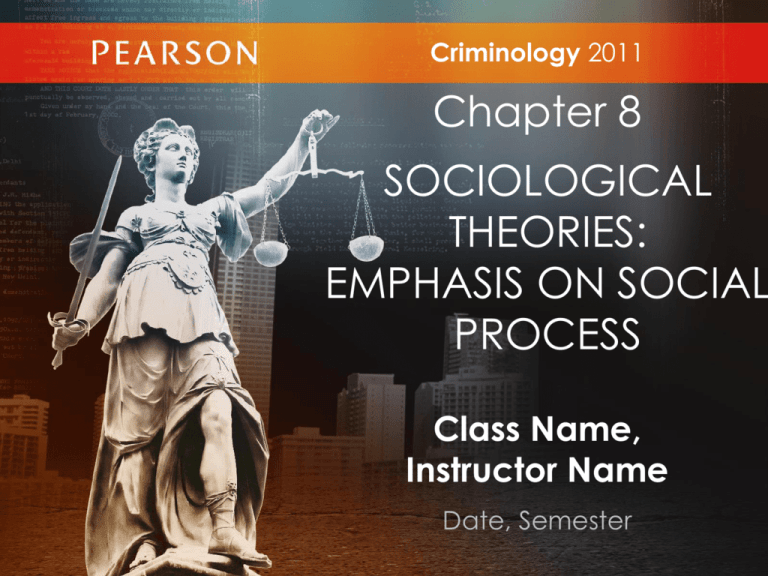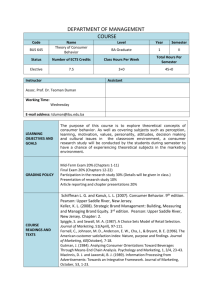
Criminology 2011
Chapter 8
SOCIOLOGICAL
THEORIES:
EMPHASIS ON SOCIAL
PROCESS
Class Name,
Instructor Name
Date, Semester
CHAPTER OBJECTIVES
8.1
Be familiar with the assumptions of learning theory.
8.2
Be able to describe and critique Sutherland's differential
association theory.
8.3
Be familiar with the other learning theories discussed in the text:
Glaser's differential identification theory, Bandura's social
learning theory, and Burgess and Akers' differential
reinforcement theory.
8.4
Be familiar with the assumptions of control theory.
8.5
Be able to describe and evaluate Reckless's containment theory.
8.6
Be able to describe and evaluate Sykes and Matza's
neutralization and drift theory.
© 2012 by Pearson Higher Education, Inc
Upper Saddle River, New Jersey 07458 • All Rights Reserved
CHAPTER OBJECTIVES
8.7
Be able to describe and evaluate Hirschi's social control theory,
including its implications for gender, race, class, and age.
8.8
Be able to describe and evaluate Gottfredson and Hirschi's selfcontrol theory.
8.9
Be familiar with Tittle’s control balance theory.
8.10
Be familiar with Colvin and Cullen’s coercive control and social
support theory.
8.11
Understand the integration of social process and structural
explanations.
© 2012 by Pearson Higher Education, Inc
Upper Saddle River, New Jersey 07458 • All Rights Reserved
CHAPTER OBJECTIVES
8.12
Be familiar with life-course theories and the life-course
approach.
8.13
Be able to describe and evaluate the specific life-course
theories discussed in the text: Elliott’s integrated strain-control
theory, Thornberry’s interactional theory, Moffitt’s life-coursepersistent/adolescence-limited theory, and Sampson and
Laub’s age-graded theory.
8.14
Appreciate the promise and problem of theoretical integration.
© 2012 by Pearson Higher Education, Inc
Upper Saddle River, New Jersey 07458 • All Rights Reserved
Learning Objectives
After this lecture, you should be able to complete the following Learning Outcomes
8.1
Be familiar with the assumptions of
learning theory.
© 2012 by Pearson Higher Education, Inc
Upper Saddle River, New Jersey 07458 • All Rights Reserved
8.1
Assumptions of learning theory:
© 2012 by Pearson Higher Education, Inc
Upper Saddle River, New Jersey 07458 • All Rights Reserved
Learning Objectives
After this lecture, you should be able to complete the following Learning Outcomes
8.2
Be able to describe and critique
Sutherland's differential association
theory.
© 2012 by Pearson Higher Education, Inc
Upper Saddle River, New Jersey 07458 • All Rights Reserved
8.2
Criminal Behavior Is Learned in Interaction with Others
in the Process of Communication
8
© 2012 by Pearson Higher Education, Inc
Upper Saddle River, New Jersey 07458 • All Rights Reserved
Learning Objectives
After this lecture, you should be able to complete the following Learning Outcomes
8.3
Be familiar with the other learning
theories discussed in the text:
Glaser's differential identification
theory, Bandura's social learning
theory, and Burgess and Akers'
differential reinforcement theory.
© 2012 by Pearson Higher Education, Inc
Upper Saddle River, New Jersey 07458 • All Rights Reserved
8.3
Differential
Identification
10
© 2012 by Pearson Higher Education, Inc
Upper Saddle River, New Jersey 07458 • All Rights Reserved
8.3
© 2012 by Pearson Higher Education, Inc
Upper Saddle River, New Jersey 07458 • All Rights Reserved
7.8
Social Learning Theory
Differential
Association
Reinforcement
Modeling/
Imitation
Social
Learning
Theory
© 2012 by Pearson Higher Education, Inc
Upper Saddle River, New Jersey 07458 • All Rights Reserved
8.3
Differential Association-Reinforcement
Theory
Differential
Association
Operant
Conditioning
Differential
Association
Reinforcement
© 2012 by Pearson Higher Education, Inc
Upper Saddle River, New Jersey 07458 • All Rights Reserved
Learning Objectives
After this lecture, you should be able to complete the following Learning Outcomes
8.4
Be familiar with the assumptions of
control theory.
© 2012 by Pearson Higher Education, Inc
Upper Saddle River, New Jersey 07458 • All Rights Reserved
8.4
Why Don’t People Commit Crime?
© 2012 by Pearson Higher Education, Inc
Upper Saddle River, New Jersey 07458 • All Rights Reserved
Learning Objectives
After this lecture, you should be able to complete the following Learning Outcomes
8.5
Be able to describe and evaluate
Reckless's containment theory.
© 2012 by Pearson Higher Education, Inc
Upper Saddle River, New Jersey 07458 • All Rights Reserved
8.5
Containment Theory
Pushes
Towards
crime
Pulls
Towards
Crime
Containment
17
The Criminal
Event
© 2012 by Pearson Higher Education, Inc
Upper Saddle River, New Jersey 07458 • All Rights Reserved
Learning Objectives
After this lecture, you should be able to complete the following Learning Outcomes
8.6
Be able to describe and evaluate
Sykes and Matza's neutralization and
drift theory.
© 2012 by Pearson Higher Education, Inc
Upper Saddle River, New Jersey 07458 • All Rights Reserved
8.6
Denying
the Victim
Condemning the
Condemners
Denial of
Responsibility
Denial of
Injury
Appeal to
Higher Loyalties
© 2012 by Pearson Higher Education, Inc
Upper Saddle River, New Jersey 07458 • All Rights Reserved
Learning Objectives
After this lecture, you should be able to complete the following Learning Outcomes
8.7
Be able to describe and evaluate
Hirschi's social control theory,
including its implications for gender,
race, class, and age.
© 2012 by Pearson Higher Education, Inc
Upper Saddle River, New Jersey 07458 • All Rights Reserved
8.7
Social Bond Theory
Conforming Behavior
Attachment
Commitment
Involvement
Belief
Family
Future
School Activities
Honesty
School
Career
Sports Teams
Morality
Peers
Family
Religious
Activities
Fairness
Personal Goals
Social Clubs
Responsibility
Criminal Behavior
© 2012 by Pearson Higher Education, Inc
Upper Saddle River, New Jersey 07458 • All Rights Reserved
8.7
Sociodemographic Factors
Gender
Age
22
Race
and
Class
© 2012 by Pearson Higher Education, Inc
Upper Saddle River, New Jersey 07458 • All Rights Reserved
Learning Objectives
After this lecture, you should be able to complete the following Learning Outcomes
8.8
Be able to describe and evaluate
Gottfredson and Hirschi's self-control
theory.
© 2012 by Pearson Higher Education, Inc
Upper Saddle River, New Jersey 07458 • All Rights Reserved
8.8
Self Control Theory
Low
Self-Control
Crime and
Analogous
Behavior
Ineffective
Parenting
© 2012 by Pearson Higher Education, Inc
Upper Saddle River, New Jersey 07458 • All Rights Reserved
Learning Objectives
After this lecture, you should be able to complete the following Learning Outcomes
8.9
Be familiar with Tittle’s control
balance theory.
© 2012 by Pearson Higher Education, Inc
Upper Saddle River, New Jersey 07458 • All Rights Reserved
8.9
Control-Balance Theory
CONTROL RATIO
(Ratio of Exercised Control Experienced)
Control
Surplus
Balance
Control
Deficit
PROBABILITY OF DEVIANCE
High
Low
High
TYPE OF DEVIANCE
Autonomous &
Acquisitive
26
Balance
© 2012 by Pearson Higher Education, Inc
Upper Saddle River, New Jersey 07458 • All Rights Reserved
Repressive &
Predatory
Learning Objectives
After this lecture, you should be able to complete the following Learning Outcomes
8.10
Be familiar with Colvin and Cullen’s
coercive control and social support
theory.
© 2012 by Pearson Higher Education, Inc
Upper Saddle River, New Jersey 07458 • All Rights Reserved
8.1
0
Social Support
Crime
REDUCES
CAUSES
Crime
Coercion Control
© 2012 by Pearson Higher Education, Inc
Upper Saddle River, New Jersey 07458 • All Rights Reserved
Learning Objectives
After this lecture, you should be able to complete the following Learning Outcomes
8.11
Understand the integration of social
process and structural explanations.
© 2012 by Pearson Higher Education, Inc
Upper Saddle River, New Jersey 07458 • All Rights Reserved
8.11
Structural
Explanations
Social Process
© 2012 by Pearson Higher Education, Inc
Upper Saddle River, New Jersey 07458 • All Rights Reserved
Learning Objectives
After this lecture, you should be able to complete the following Learning Outcomes
8.12
Be familiar with life-course theories
and the life-course approach.
© 2012 by Pearson Higher Education, Inc
Upper Saddle River, New Jersey 07458 • All Rights Reserved
8.12
Childhood
Problems
Adolescent
Delinquency
Adult
Criminality
© 2012 by Pearson Higher Education, Inc
Upper Saddle River, New Jersey 07458 • All Rights Reserved
Learning Objectives
After this lecture, you should be able to complete the following Learning Outcomes
8.13
Be able to describe and evaluate the
specific life-course theories discussed in the
text: Elliott’s integrated strain-control theory,
Thornberry’s interactional theory, Moffitt’s
life-course-persistent/adolescence-limited
theory, and Sampson and Laub’s agegraded theory.
© 2012 by Pearson Higher Education, Inc
Upper Saddle River, New Jersey 07458 • All Rights Reserved
8.13
Strain
StrainControl
Theory
Social Control
Social Learning
© 2012 by Pearson Higher Education, Inc
Upper Saddle River, New Jersey 07458 • All Rights Reserved
8.13
Thornberry's Interactional Theory
Weakened Bond
to Conventional
Society
Cause of
Delinquency
Environment in
Which
Delinquency Can
Be Learned;
Rule-Violating
Behavior Is
Rewarded
© 2012 by Pearson Higher Education, Inc
Upper Saddle River, New Jersey 07458 • All Rights Reserved
8.13
Moffitt’s Dual Taxonomic Theory
Prevalence of Antisocial Behavior
100%
36
90%
80%
70%
60%
50%
40%
30%
Adolescence
Limited
20%
10%
Life Course
Persistent
© 2012 by Pearson Higher Education, Inc
Upper Saddle River, New Jersey 07458 • All Rights Reserved
8.13
Moffitt’s Dual Taxonomy:
Adolescent Limiteds
Delinquency
Little to No
Antisocial Behavior
Childhood
Desist: No Adult Crime
Overcome
Maturity Gap
Maturity Gap Closed
Social Mimicry
Costs of Crime Rise
Adolescence
Adulthood
© 2012 by Pearson Higher Education, Inc
Upper Saddle River, New Jersey 07458 • All Rights Reserved
8.13
Moffitt’s Dual Taxonomy:
Life-Course Persistent
Antisocial Conduct
Neuro-Psychological
Deficits & Environment
Childhood
Serious
Delinquency
Continue
Criminal Behavior
Cumulative
Consequences
Adolescence
Adulthood
© 2012 by Pearson Higher Education, Inc
Upper Saddle River, New Jersey 07458 • All Rights Reserved
8.13
Laub and Sampson's
Age-Graded Theory
Turning Point:
Marriage
Adult
Criminal
Behavior
Establish
Social Bonds
With Adult
Institutions of
Informal
Social Control
Desist
from Crime
Turning Point:
Employment
© 2012 by Pearson Higher Education, Inc
Upper Saddle River, New Jersey 07458 • All Rights Reserved
Learning Objectives
After this lecture, you should be able to complete the following Learning Outcomes
8.14
Appreciate the promise and problem
of theoretical integration.
© 2012 by Pearson Higher Education, Inc
Upper Saddle River, New Jersey 07458 • All Rights Reserved
8.14
Promise
vs.
Problems
© 2012 by Pearson Higher Education, Inc
Upper Saddle River, New Jersey 07458 • All Rights Reserved
CHAPTER SUMMARY
8.1
Be familiar with the assumptions of learning theory.
8.2
Be able to describe and critique Sutherland's differential
association theory.
8.3
Be familiar with the other learning theories discussed in the text:
Glaser's differential identification theory, Bandura's social
learning theory, and Burgess and Akers' differential
reinforcement theory.
8.4
Be familiar with the assumptions of control theory.
8.5
Be able to describe and evaluate Reckless's containment theory.
8.6
Be able to describe and evaluate Sykes and Matza's
neutralization and drift theory.
© 2012 by Pearson Higher Education, Inc
Upper Saddle River, New Jersey 07458 • All Rights Reserved
CHAPTER SUMMARY
8.7
Be able to describe and evaluate Hirschi's social control theory,
including its implications for gender, race, class, and age.
8.8
Be able to describe and evaluate Gottfredson and Hirschi's selfcontrol theory.
8.9
Be familiar with Tittle’s control balance theory.
8.10
Be familiar with Colvin and Cullen’s coercive control and social
support theory.
8.11
Understand the integration of social process and structural
explanations.
© 2012 by Pearson Higher Education, Inc
Upper Saddle River, New Jersey 07458 • All Rights Reserved
CHAPTER SUMMARY
8.12
Be familiar with life-course theories and the life-course
approach.
8.13
Be able to describe and evaluate the specific life-course
theories discussed in the text: Elliott’s integrated strain-control
theory, Thornberry’s interactional theory, Moffitt’s life-coursepersistent/adolescence-limited theory, and Sampson and
Laub’s age-graded theory.
8.14
Appreciate the promise and problem of theoretical integration.
© 2012 by Pearson Higher Education, Inc
Upper Saddle River, New Jersey 07458 • All Rights Reserved





